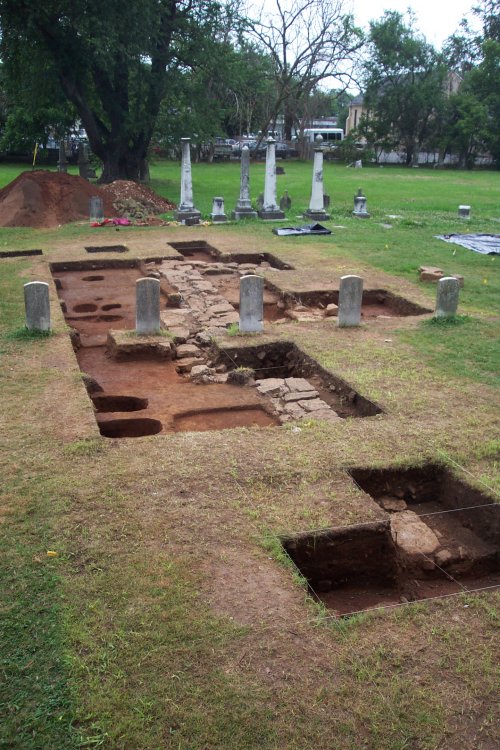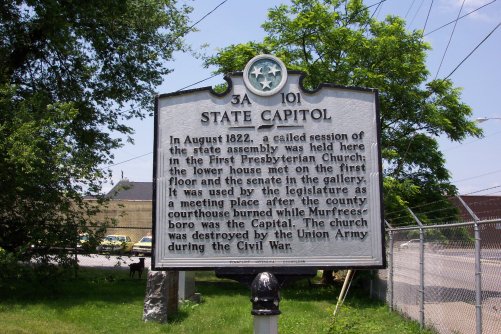
June 2-July 3, 2003

| The Old First Presbyterian Church Archaeological Project June 2-July 3, 2003
|
Research on the First Presbyterian Church and Old City Cemetery is an
on-going process, so the information contained in this brief background
should be considered a "work-in-progress" subject to change as more
detailed research is completed.
In June 1811, Reverend Robert Henderson first held religious services in
the vicinity that would in four months become a new town chartered by the
state legislature. On October 17, 1811, the new county seat of Rutherford
County (formed in 1803) was designated by the state legislature as
Cannonsburgh. Apparently at the behest of Captain William Lytle, the
Legislature rescinded that action on November 29, 1811 and renamed the
county seat Murfreesborough.
By April 1812, Dr. Henderson, three elders, and fifteen subscribing
members denominated the Murfree Spring Presbyterian Church. The original
meeting place of the congretation was a log school-house, located on land
near the Murfree Spring. Between 1812 and 1820, the congregation met in
this schoolhouse, another log schoolhouse located on what is now East Main
Street, and the Rutherford County Courthouse (completed in 1813).
In 1818, the name of the church was changed to the First Presbyterian
Church of Murfreesboro. With a growing congregation, the erection of a
church home became a major fundraising goal. Captain William Lytle
donated a small lot on Vine Street to the elders of the First Presbyterian
Church. By 1820, the congregation had completed construction on the first
church building in Murfreesboro -- a building then considered one of the
finest, largest, and most elegant in the county.
As recounted by Spence, the church was: A brick building forty by
sixty ft, two storys, windows, painted shutters, three doors in front, two
leading to the gallery, finishing off with a cupaloe [sic], about seventy
feet high, neatly finished with painted shutters, a large golden ball on
the top, a hundred and twenty five pounds bell. The inside work, a
gallery on two sides and end, pannel [sic] work all round, also three rows
seats round the gallery. The whole supported above and below with turned
pillars, standing at proper distance apart. The lower story, all pewed,
closed with doors. An elevated pulpit, about three feet from the floor,
stair way either side for entrance with doors, seating three men. All
well finished and neatly painted. Pews all numbered on the doors. This,
the general appearance. The work of the whole building was undertaken by
Benj. Goldson, at a cost of about four thousand dollars. The church was
completed in 1820.
Soon thereafter, the church also created a graveyard -- which served as
final resting place not only for the church members, but also apparently
as the de facto public cemetery for the citizens of
Murfreesboro.

This first church is also unique in that it served as the State Capitol Building of Tennessee during the 1822 legislative session. Murfreesborough served as the capital city of Tennessee from 1818 through 1826. While the Rutherford County Courthouse served as the meeting place of the state legislature during most of those years, the original courthouse burned in 1822 just prior to the meeting of the state legislature. The citizens of the relatively new town of Murfreesboro renovated the church in time to house the legislature. The Senate met in the upper floor and the House met in the lower floor.
While each meeting of the state legislature brings important decisions and events, the year 1822 was an auspicious one in terms of local, state, and national history. Indeed the period from 1818 to 1826 when Murfreesboro served as the capital city was one of significant events and history-making changes.
During the time Murfreesboro served as the state capital, Tennessee changed radically under the leadership of Governors Joseph McMinn (1815-21) and William Carroll (1821-26; 1829-34) and the General Assembly. During McMinn’s tenure, fourteen new counties were created as West Tennessee was opened for settlement after the Chickasaw Purchase Treaty. Both McMinn County and McMinnville are named for him. Governor William Carroll held the office of Tennessee Governor longer than any other person. During his twelve years as governor, the state progressed from a frontier society to one in which towns and cities were developing quickly. Remembered as Tennessee’s “Reform Governor,” he is credited with reform of penal laws, the establishment of chancery courts, and the adoption of the new State Constitution of 1834.
More specifically with reference to sessions held in the Church, the state legislature voted to nominate Andrew Jackson for President of the United States in 1822. In the presidential campaign of 1824, Jackson received a plurality in a contest among William H. Crawford, John Quincy Adams, Henry Clay, John C. Calhoun, and Jackson. However, in action reminiscent of more recent presidential elections, because the votes were split without a requisite majority, the House of Representatives gave the presidency to Adams. Jackson labeled the transaction “a corrupt bargain” that violated the will of the voters. Jackson’s advisors launched his more successful presidential campaign of 1828 with no few references to that charge.
In 1837, the City of Murfreesboro purchased land adjacent to the church cemetery to serve as the official public cemetery for Murfreesboro. The remains of the church, the church cemetery and the city cemetery are now included as a single piece of property known as "The Old City Cemetery."
The church building and cemetery were also to play a significant role during one of the most cataclysmic events in national history -- the Civil War. Just prior to the Battle of Stones River, the Confederate Army established a hospital in the church -- the last church service of the war was held in the October 1862. During and after the battle, Confederate surgeons remained behind and attended both Confederate and Union wounded for several weeks. As recorded by C. Lewis Diehl with the United States 15th Pennsylvania Cavalry:
The United States Commissariat supplied this hospital with stores to-day (January 7, 1863). The weather has been cool…. The hospital in which we are is an old Presbyterian Church and might be made very comfortable, but as it is we have nothing except straw ticks to lay on and a thin blanket for cover, with corn fodder for a pillow. The surgeons - rebel - treat us very kindly and are doing as much for us as they do for their own men. The ladies - rebel - who visit this hospital generally slight us. Some few will attend to our wants. There was a general apprehension by the rebels that our men would not treat them kindly; but since they have received our stores, with permission to help themselves to whatever they need, they think differently.
James Searcy with the Confederate States Lumsden’s Battery volunteered to remain in Murfreesboro and help tend his brother and other Confederate wounded. He wrote:
(My brother) Reuben died … Wednesday morning (January 7, 1863) after a week and night of intense suffering… we buried him … (Thursday) morning in the Church yard of the old School Presbyterian church. I have the spot well marked. A head stone with his name deeply cut in it.
The burials of perhaps as many as 500 soldiers from both sides once filled portions of the city cemetery -- eventually to be retrieved by relatives or relocated to Confederate and Union cemeteries established between 1865 and 1867. Most of these soldiers are now resting in Evergreen Cemetery (Confederate) or the National Cemetery at Stones River.
After creation of a larger and more permanent Federal field hospital, the church was converted into a stable and supply warehouse. At a meeting of Reverend Eagleton and two of the church elders on July 18, 1863, the minutes record that:
There has been an unprecedented destruction of property both private and public, and even the resting-places of the dead, where the remains of many dear, loved ones were deposited and the sanctuary itself, where we & many of the venerated dead had been accustomed to meet for the worship of God, have been and still are desolated and desecrated!
During the hard winter of 1863-1864, the destruction of the church was completed. The wooden fixtures were used as firewood. The brick was hauled off to construct chimneys and ovens for the troops stationed in the area. By March 1864, the once magnificent structure was reduced to a vacant lot.
As Joseph W. Nelson wrote to friends in Texas from Murfreesboro on June 21, 1866: Our town & county have been greately darnaged by the two Armies, they distroed all the tember for miles a round burnt all the rails for 3 or 4 miles in all directions burnt & pulled down at least 50 houses in town & of the number was the Old Presbyterian Church, destroed the fence a round the graves broke toombstones & desscerated the grave yard generally.
Both the congregation of the First Presbyterian Church and the officials of the City of Murfreesboro apparently felt that this once hallowed ground now carried too many bad memories. In 1868, the congregation purchased a lot on the corner of College and Spring streets and built a new church home. This second church stood until March 21, 1913 when a tornado largely destroyed the building. It was rebuilt on the same lot in 1914 and now serves as the current home of the First Presbyterian Church of Murfreesboro -- a building listed on the National Register of Historic Places.
In the spring of 1872, the city of Murfreesboro purchased twenty acres from Dr. James Maney for a new city cemetery - established as "Evergreen Cemetery." Many families purchased lots at Evergreen and moved their ancestors from the Presbyterian Church graveyard to this new location.
Out of sight and eventually out of most minds, the site of the original First Presbyterian Church faded into a corner of the fenced property now known as "The Old City Cemetery."
We hope to "rediscover" it through this project.